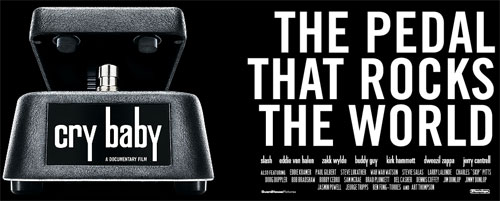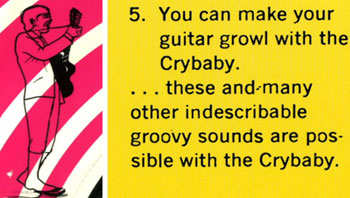Review: Cry Baby Doc Worth Checking Out

The documentary “Cry Baby: The Pedal that Rocks the World” was released a few months back. Did you hear about it?
Since I’m not a frequent Cry Baby (or any wah or pedal) user, I didn’t feel compelled to track it down for a look-see. But then I saw recently that the entire movie – about an hour, and you can watch it with one click (not 10 parts on YouTube) – is available online. So I decided to check it out.
Glad I did. Didn’t get any tone nuggets out of it, but it was interesting to hear how the pedal was developed and how Jim Dunlop ended up with it (it was owned by Thomas Organ Co., a division of Whirlpool and Whirlpool wanted out), as well as what various artists and producers had to say.
Following are some notes I banged out on things that stood out for me:
The Beginning
> Thomas distributed Vox amps in the U.S. The Cry Baby resulted from a desire of the company to save $3 per amp by getting rid of the pricey MRB (MidRange Boost) switch. The answer, developed in just one morning by employee and Cry Baby inventor Brad Plunkett, was to put the midrange in a pot (potentiometer), which was much cheaper.
> How’d they get the name? Someone at Hammond said the sound was like a baby crying.> The term “wah wah” came from someone saying it sounded like a trumpet player using a mute in the bell (the trumpet/mute was even mentioned in the patent app). In fact, a trumpeter named Clyde McCoy had a tune out called Wah Wah, Hammond licensed his name and presumably that term, and that’s why Clyde’s name is on the bottom of early Vox wahs – which are exactly the same as early Cry Baby wahs (Cry Baby was the brand sold to non-Vox dealers).
> Del Casher, a guitar player, was the first guy who realized that the Cry Baby was a guitar effect. In fact, he probably got Frank Zappa onto it – Zappa was one of the earlist users of the pedal.
Artists
> Eddie Kramer – “Jimi was the complete and utter master of his craft and of the use of the wah wah. Period, end of story.”
> Kramer on Jimi’s playing generally: “You think [watching him], that’s physically impossible. Because he was so integrated with the thought process from the brain to the heart into the fingers to the feet, it’s all one fluid motion.”
> Kramer said Jimi played Voodoo Child through a Fender Dual Showman with an 8×10 cab.
> EVH noted that Geezer Butler played a wah “solo” on the first Sabbath album.
> Stevie Salas is in the doc! Awesome player, one of my favorites, here’s one of my fave Salas tunes with a wah. Crack Killed Applejack!
Tweaks
> Like much early gear (amps, pickups, some pedals), early wahs had different parts from unit to unit so some sounded great, others not so much.
> Kramer said that Hendrix and Roger Mayer tweaked Jimi’s wahs to make it have a lower tone. Mayer “would change all kinds of crap in there to give it a different feel,” Kramer said.
> EVH said, “I would always change the setting from the factory setting because I don’t like for it to go really bright.” Yet more evidence that he tweaked everything so it sounded good to him….
In the Chain
> Bob Bradshaw said not to put it first in the chain, to have the distortion boxes first.
> EVH said he always puts it first – “I plug my guitar into it and everything else after it. It’s the first thing.” So does Paul Gilbert.
> Stevie Salas says he sometimes puts it first in the chain, sometimes later to make it almost a tone generator.
Using It
> Slash – “The Cry Baby is a very personal effect. The way that it sounds is totally at the mercy of the user. So you have to figure out what it is that you want to get out of it and [then] try to pull that off.”
> Charles “Skip” Pitts, the guy who played the wah on the Shaft movie theme said something interesting – that the wah mirrors “whatever rhythm you have in you, that you have in your feet.”
> Gilbert – “I always recommend…make as many faces as you can and link them up to the sounds. And the wah wah is just going to multiply that by 10.”
One of favorite uses of the wah, starts at 3:15
Other
> After the ’80s rack and grunge movements, Stevie Ray Vaughan revived the wah. Notably Voodoo Chile and Soul to Soul wherein he was rumored to have worked two wahs simultaneously.
> Some scary playing by Dime at about 49:33. Effortless and cool. Taken from the following footage – wah part starts at 2:05 below (F-word alert).
> Lots of guys dug Michael Schenker’s cocked wah sound.
> A Dunlop engineer said, “You can never replicate perfectly a wah wah passage. That’s what makes it organic, and that’s what makes it timeless.”
> Zakk Wylde – “Just like beer, pretzels, and peanut butter and jelly, certain things are just not going to go out of style” – meaning, of course, the wah.
Bottom Line
Is the movie worth the 57:22 of your time? Yes. Does it bring to light the need for a documentary on MXR pedals? Heck yeah!
Wah Tunes Mentioned in the Doc
Jeff Beck, ‘I Ain’t Superstitious.’ one of Slash’s favorite wah tunes
Rose Royce, ‘Car Wash’
Shaft theme – Pitts hated playing this simple wah part!
Alice in Chains, ‘Man in a Box’ (wah + talk box)
Category: Dunlop/Cry Baby, Edward Van Halen, Effects, Jeff Beck, Jimi Hendrix, Paul Gilbert, Randy Rhoads, Reviews, Roger Mayer, Slash, Stevie Ray Vaughan, Stevie Salas, Vox















“After the ’80s rack and grunge movements, Stevie Ray Vaughan revived the wah”-This is just plain WRONG.
A. Stevie came BEFORE the grunge movement, at the same time as glam/hair metal.
B. Every Grunge band not named nirvana or the melvins rocked the wah wah. Its all over Soundgarden, Mudhoney, Pearl jam, Skin Yard and TAD’s albums, and you even have Alice in Chains mentioned in your post. Hell, even Cobain used a wah wah on the song “Love Buzz”. Wah-Wah guitar is considered one of the grunge cliches by people who actually know about the pacific northwest bands who sprung up from the mid 80’s to the early 90’s.
BTW-If you actually pay attention, the documentary gets the chronology right and mentions the grunge guys as coming after Stevie and that they used the wah-wah pedal as well. Stevie did challenge the rack gear fever that was taking hold in the 80’s, but so did the grunge guys, as they went back to the classic wah-wah & stompbox fuzz & distortion fx.